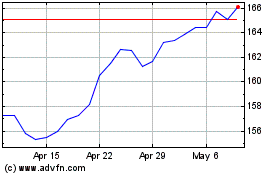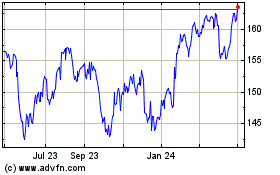By Sharon Terlep
Household goods from diapers to toilet paper to razors are
getting cheaper, but what is a boon for shoppers is squeezing
profits at the world's biggest consumer-goods companies.
Under pressure to boost sales, Procter & Gamble Co. resorted
to widespread discounting late last year to win back customers.
P&G, which makes Tide detergent and Pampers diapers, said
Tuesday that average prices on its products fell in the most recent
quarter for the first time since 2011.
Kimberly-Clark Corp., which sells Huggies diapers and Kleenex
tissues, partly blamed its rival's lower prices for weak sales as
it unveiled a broad restructuring Tuesday, including at least 5,000
layoffs.
A healthy U.S. economy and the lower corporate tax rate have
done little to alleviate the challenges these companies face.
Retailers such as Wal-Mart Stores Inc. are pushing for steeper
discounts as they struggle to compete with Amazon.com Inc.
Meantime, costs of pulp, oil and other raw materials used in the
products have risen more than expected.
The dynamics are setting up a tug of war this year between
consumer-products companies that are pouring money into new
products and marketing in hopes of commanding higher prices, and
retailers and shoppers increasingly accustomed to discounts.
Kimberly-Clark Chief Executive Tom Falk said in an interview
that P&G's discounting, along with pressure from retailers and
a decline in the U.S. birthrate, have reduced demand for the
company's baby-related products and other items. That is driving
the industrywide push to cut prices, he said.
However, Mr. Falk said, the competition hasn't reached the
intensity of previous eras. "It's not the worst I've ever seen by
far," he said, recalling a time in the 1990s when P&G cut
diaper prices by 10%. "There have been more aggressive price
wars."
P&G, Kimberly-Clark and Johnson & Johnson reported
earnings Tuesday. J&J CEO Alex Gorsky told analysts and
investors on a conference call that the company's consumer-health
business had maintained market share despite a "global category
slowdown" in the market for the goods.
He acknowledged J&J needed to do more to accelerate the
consumer-health unit's growth, and pledged to take a number of
steps. That includes "relaunching" the Johnson's Baby franchise,
which includes baby shampoo, "with new formulations and new
packaging to meet the purchasing preferences of millennial
parents."
For its part P&G aims to combat price pressure with new
offerings and by focusing on the higher end of the market, where
products have richer margins and shoppers are more willing to
spend, finance chief Jon Moeller said on a call with analysts. He
pointed to the company's new Oral B power toothbrush and pricier
new Olay skin-care products as examples, and added that the
discounting won't last.
Lower prices had the biggest impact in P&G's grooming
segment, where the company last year took the unusual step of
publicly announcing plans to slash prices across its Gillette razor
brand amid market share losses to cheaper online competitors. But
pricing also fell by 1% on average in its health-care, household
goods and personal-care units.
P&G has been under pressure from activist investor Trian
Fund Management to improve its performance, and recently ended a
high-profile proxy fight by giving Trian co-founder Nelson Peltz a
seat on its board. Mr. Peltz has argued the company is overly
complex and has failed to keep pace with recent trends.
Bernstein analyst Ali Dibadj questioned whether lower prices are
a new reality for the industry, a particular concern for investors
as prices on raw materials have been going up.
"Arguably you have been pricing below your market inflation
rates for years now," Mr. Dibadj said on the call with P&G. In
the consumer-products industry, "pricing not keeping up with
inflation seems to be a bit of a trend now. Is this retailers
pushing back? Are consumers saying, 'These are commodities?' "
In response, Mr. Moeller said, "You are right to point to this
as a pain point in the immediate present." P&G said it didn't
start the price war.
Price reductions by big household brands are overdue, said Gary
Stibel, founder of New England Consulting Group in Westport, Conn.,
in an interview.
"Prices have gone so high they've made themselves vulnerable to
discounters," he said. "When you take pricing [increases] year
after year, you raise the umbrella to a point that others can slip
underneath it."
U.S. pricing on Kimberly-Clark's disposable diapers dropped 0.8%
last year, while P&G's diaper prices fell 0.4%, according to
Nielsen figures provided by Wells Fargo. Paper-towel prices slid
2.7% last year for Kimberly-Clark, while P&G's paper-towel
prices rose 1.8% for the year. Nielsen's figures exclude online
sales, some retailers and promotional activity, such as
coupons.
P&G said organic sales, a closely watched metric that strips
out currency moves, acquisitions and divestitures, rose 2% in the
quarter ended Dec. 31.
In all for its fiscal second quarter, the Cincinnati-based
company reported earnings of $2.5 billion, or 93 cents a share,
down from a profit of $7.88 billion, or $2.88 a share, a year
earlier. The prior year's quarter included a benefit from a
divestiture. On an adjusted basis, earnings rose 10% to $1.19 per
share. Quarterly revenue rose 3.2% to $17.4 billion.
P&G's decision to streamline its beauty business by selling
the bulk of it to Coty Inc. in 2016 helped organic sales in the
segment to jump 9% -- the largest margin among company segments --
during the quarter.
Kimberly-Clark said it would cut about 13% of its global
workforce, or at least 5,000 jobs. The Irving, Texas-based company
had entered 2017 predicting 2% organic sales growth but ended the
year with flat sales. It expects just 1% growth for 2018.
Imani Moise and Jonathan D. Rockoff contributed to this
article.
Write to Sharon Terlep at sharon.terlep@wsj.com
(END) Dow Jones Newswires
January 23, 2018 19:41 ET (00:41 GMT)
Copyright (c) 2018 Dow Jones & Company, Inc.
Procter and Gamble (NYSE:PG)
Historical Stock Chart
From Mar 2024 to Apr 2024

Procter and Gamble (NYSE:PG)
Historical Stock Chart
From Apr 2023 to Apr 2024
